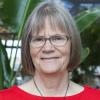Friday Flyer - December 12, 2014
Spotlight on Kansas State University: KSU has an active group of teachers engaged in many things in QuarkNet; 22 teachers are members. Many of these teachers come from small, rural high schools, but these schools have active physics instruction. This past year two activities attracted the teachers. The masterclass in April was a big draw; nine teachers and 24 students participated, including a tour of the KSU nuclear reactor. The physics department HEP and cosmology graduate students were assistants. Then in August, six teachers worked with four cosmic ray detectors to learn how to take and analyze data with Cosmic Ray e-Lab tools. An emersion experience let the teachers work with the cosmic ray project from a student vantage. This allowed teachers to understand the students' research experience, struggles and excitements, when doing cosmic ray research back in the classroom.
The KSU center benefits from the long-term support from Martin Shaffer. Martin “graduated” from teaching high school physics at Seaman High School in Topeka and now teaches at Cowley Community College. Still, Martin, a former fellow, volunteers to visit QuarkNet teachers offering support and coaching. For Martin, have detector, will travel is an SOP. Numbers of Kansas teachers have benefited from his assistance and expertise. In addition, he is a co-author of the detector plateauing instructions found within the CR e-Lab Library. Martin travels the world doing QuarkNet outreach and sharing his knowledge.
Another friendly interloper travels to KSU; Jim Deane technically belongs to the University of Kansas QuarkNet Center. But, KU does not participate in masterclass, so Jim and his students make the trip to Manhattan. He has been a leader in the KU group, and, like Martin, others get to learn from his use of HEP in the classroom. Hats off to both Martin and Jim.
News from QuarkNet Central: We have a new Standard Model poster, courtesy of the Linear Accelerator Laboratory in Orsay, France, and the International Particle Physics Outreach Group, that you can view and download as a PDF. It's a big file and is best printed in large poster format.
And just when you thought it was safe to peruse the Friday Flyer, here is another QuarkNet an der Elbe from Ken.
Physics Experiment Roundup: Meet the Dark Matter Detectives. (from Air & Space Magazine)
Resources: Watch the video of Brian Nord to learn why L(HC) stands for large.
Just for Fun: The Millenium Simulation Project: 10B particles trace the evolution of the matter distribution in a cubic region of the universe over 2B light-years on a side.
QuarkNet Staff Teachers:
Ken Cecire: kcecire@nd.edu
Tom Jordan: jordant@fnal.gov
Bob Peterson: rspete@fnal.gov
